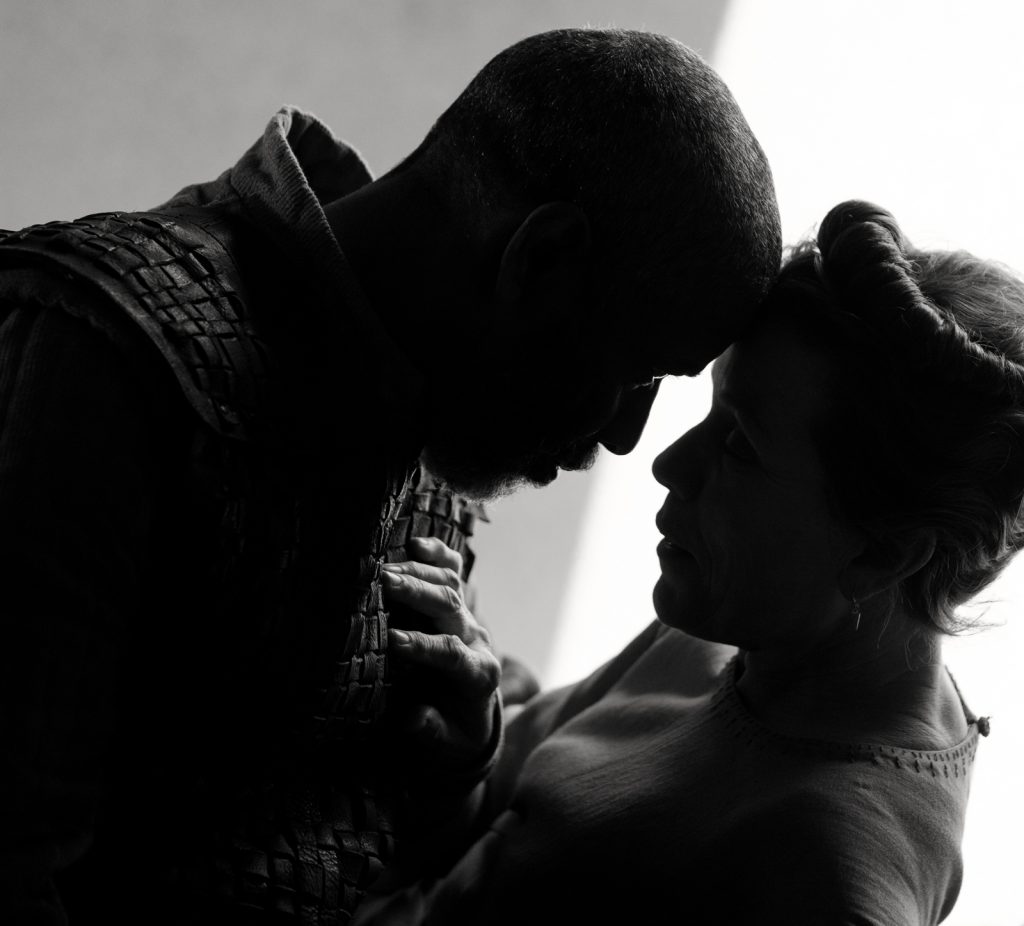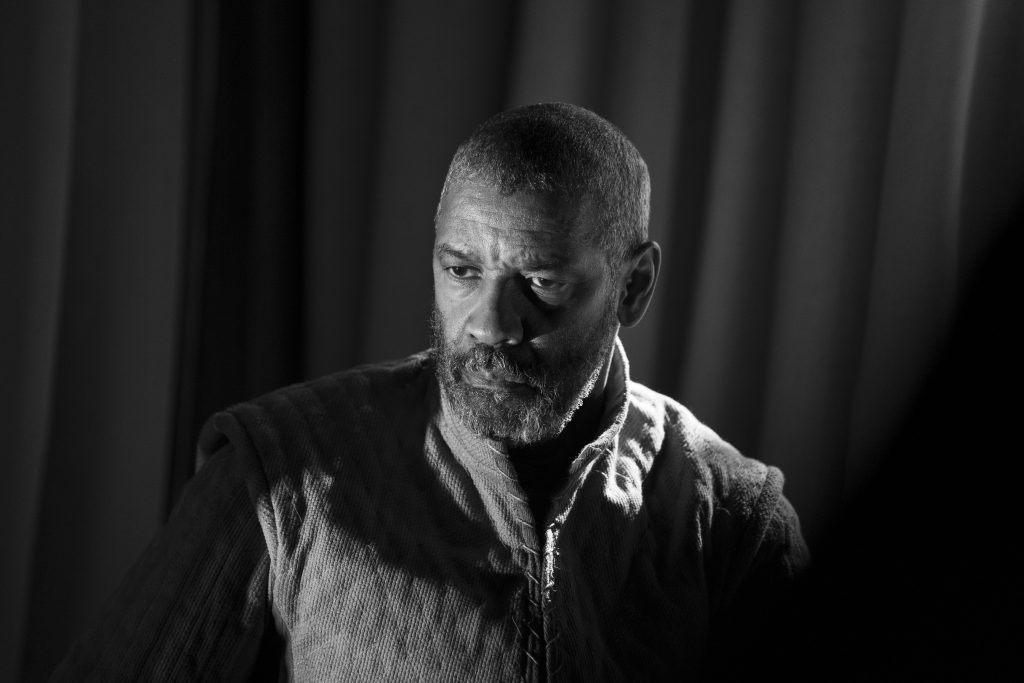September 24, 2021
by Carla Hay

Directed by Joel Coen
Culture Representation: Taking place in Scotland and England in the 1600s, the dramatic film “The Tragedy of Macbeth” features a cast of white and black people representing the working-class, middle-class and royalty.
Culture Clash: A ruthlessly ambitious husband and wife lie, cheat and murder their way into becoming king and queen of Scotland, but their sins eventually catch up to them with deadly consequences.
Culture Audience: Besides the obvious target audience of fans of William Shakespeare’s “Macbeth” play, “The Tragedy of Macbeth” will appeal primarily to fans of Oscar winners Denzel Washington, Frances McDormand and Joel Coen.

“The Tragedy of Macbeth” gives William Shakespeare’s play “Macbeth” the minimalist treatment, laying bare the raw intensity of the story, which is masterfully channeled via powerhouse performances from Denzel Washington and Frances McDormand. Joel Coen (McDormand’s husband and longtime artistic collaborator) wrote and directed “The Tragedy of Macbeth” as a striking hybrid of an observational filmed stage play and an immersive cinematic experience. At a relatively brisk run time of 105 minutes, the movie defies the notion that movies made from Shakespeare’s work have to be pompous, self-indulgent bores. “The Tragedy of Macbeth” had its world premiere at the 2021 New York Film Festival.
Filmed in black and white, “The Tragedy of Macbeth” stays faithful to the source material but rolls out as a more streamlined piece of art that makes this version of the Macbeth story more accessible to people with short attention spans. People interested in watching the movie probably have some familiarity already with Shakespeare’s “Macbeth,” a tragic play that was first performed in 1606 and first published in 1623. Most people would agree that “Macbeth”—with its timeless themes of how a corrupt pursuit of power can destroy lives—remains among the top three of Shakespeare’s best and most well-known work.
There’s really no need to rehash a plot that a lot of viewers will know before seeing this movie. The story is essentially about a married power couple who want to rule over Scotland as king and queen, no matter what the cost. Washington portrays the title character as a man on a mission to get what he feels is owed to him after years of feeling unappreciated as a loyal lord to Scotland’s King Duncan (played by Brendan Gleeson), who is about to be viciously murdered.
The mastermind of this assassination is Macbeth’s wife Lady Macbeth (played by Frances McDormand), whose power and intelligence is underestimated by most people because she is a woman. However, behind the scenes and behind closed doors, Lady Macbeth is a master manipulator who is in many ways more cold-hearted and single-minded in her ambition than her husband is. When he has doubts about any of the dastardly deeds that she has in mind, she pushes those doubts out of his mind and motivates him to follow through with her plans.
Clawing one’s way to the top of Scotland’s royal hierarchy, without being a blood relative of a royal, means that a lot of people will have to die. (The killing scenes aren’t too gory, but there are a few non-explicit scenes involving child murder that might be disturbing for very sensitive viewers.) King Duncan has two adult sons: elder son Malcolm (played by Harry Melling) and Donalbain (played by Matt Helm), who are dutiful but unprepared for the destruction inflicted by the Macbeth couple. As the body count piles up, false accusations will fly, paranoia reaches a fever point, and certain people face a reckoning that seems to ask the question: “Was all that backstabbing worth it in the end?”
Other characters in the play that are also in the movie include Banquo (played by Bertie Carvel), Macbeth’s close ally and a general in King Duncan’s army; Fleance (played by Lucas Barker) Banquo’s son, who’s about 10 or 11 years old in the movie; Macduff (played by Corey Hakwins), Thane of Fife; and Lady Macduff (played by Moses Ingram), Macduff’s wife. Macduff is the first one in the king’s inner circle to suspect that Macbeth and his wife might be up to no good.
Just like like in the “Macbeth” play, the catalyst for Macbeth thinking he has a right to take the throne comes early on in the story when he envisions three witches who tell him a prophecy that he will become the king. However, the introduction of these witches in the movie doesn’t follow standard convention. At first, there’s the appearance of one witch (played by Kathryn Hunter, who plays all three identical witches), who is first seen with her face down in a sandy and barren area, like a vulture who’s hunched over from dehydration.
This witch, just like her look-alikes, is dressed all in black has bird-like mannerisms and even caws like a crow. She contorts her body and flaps her arms, like an ave from hell. And later, when she is joined by the other two witches, they transform into large and menacing black birds.
Washington’s portrayal of Macbeth is as a hothead who is prone to losing control of his emotions and stomping around and shouting as a way to intimidate people. Macbeth is all about short-term gratification. McDormand’s depiction of Lady Macbeth is as someone who is more likely to think long-term and see the big picture.
The difference between Lady Macbeth and her husband is that Lady Macbeth knows when to keep her mouth shut and not give away too much information. Witness the brilliant facial expressions of McDormand as Lady Macbeth in a scene where her husband Macbeth is ranting about something to a group of people in the king’s court. Lady Macbeth thinks he might let some valuable information slip, but she says nothing in order to keep up a façade of ignorance. However, the look on her face shows a brief flash of alarm, as if she’s thinking, “He better not say anything stupid!”
Lady Macbeth has a temper too. She just doesn’t show it to people who could use this “unladylike” demeanor against her. And when McDormand’s Lady Macbeth gets angry, she bellows and barks in a voice that’s deep enough to sound like a man. McDormand’s interpretation of Lady Macbeth is that she knows her own power and strength. She’s not a fussy and frilly wife but one who’s willing to blur the lines of gender roles by showing a more masculine side than how other female actors might interpret this character.
“The Tragedy of Macbeth” has some recurring visual motifs that work well for a movie that was filmed in black and white and has a mild fascination with flight in open skies. First, there are multiple scenes that have a starry night as a backdrop. In a memorable moment, Lady Macbeth let’s go of a burning piece of paper, which flies out the window and into the night. And when the witches turn into birds, which happens more than once in the movie, it also exemplifies the type of flight that conjures of images of dark forces that hover and can’t be tamed.
Another effective visual technique that’s used in “The Tragedy of Macbeth” is conveying the feeling of being spied on and targeted. A scene with Banquo opens with what looks like a spotlight resembling a bullseye lens. The camera zooms up to show an aerial view of Banquo in this spotlight. It’s a foreshadowing of what happens later to Banquo, because he indeed becomes a target. And later in the movie, the three witches are perched on wooden square beams, as the witches look down like vultures ready to pounce.
Because there have been so many different adaptations of “Macbeth,” Coen succeeds in the intent to offer Macbeth through the lens of living in a world where generations of filmmakers and movie audiences have been influenced by the nightmarish lighting contrasts of German Expressionism. The movie’s cinematography (by Bruno Delbonnel), production design (by Stefan Dechant) and visual effects (supervised by Michael Huber and Alex Lemke) are stark and compelling, ranging from set pieces that look like they were made for a theater stage to the majestic simplicity of a cliff that becomes a pivotal location.
And when Lady Macbeth literally lets her hair down in private moments, she can be disheveled—more frump and happenstance than pomp and circumstance. Occasionally messy hair aside, Lady Macbeth’s wardrobe and the rest of the characters’ clothes are completely on point, thanks to stellar costume design by Mary Zophres. The costumes in “The Tragedy of Macbeth” might be the only reason to wish that this movie hadn’t been in black and white. However, the film’s monochromatic pallette is understandable, in order to reflect the dark despair that permeates throughout the story.
The members of this movie’s international cast use their natural accents. Most of the cast members are British. Washington, McDormand and Hawkins are American, while Gleeson is Irish. The varied accents are not a distraction, because the words of Shakespeare make everything sound very much of the era in which it was written. Accents just sound more classical when quoting Shakespeare.
All of the supporting actors in “The Tragedy of Macbeth” play their roles well, with Hawkins being a standout as the intuitive Macduff, a good man who loves his wife and kids and who finds himself in the crosshairs of death and betrayal. It’s hard to go wrong with a Shakespeare classic, a cast of this high level of talent, and a director who consistently makes films whose quality is above-average. The “Macbeth” story is a well-worn road for enthusiasts of performing arts, but “The Tragedy of Macbeth” makes this familiar ride very entertaining.
A24 will release “The Tragedy of Macbeth” in select U.S. cinemas on December 25, 2021. Apple TV+ will premiere the movie on January 14, 2022.
